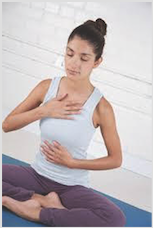- Home
- Archive -Jan 2017
- Receive in abun. . .

Receive in abundance
- In :
- Body Column Jan 2017
January 2017
By Saraswathi Vasudevan
In the third of her series on right breathing, Saraswathi Vasudevan imparts the secrets of good inhalation
In normal breathing inhalation is an active process. When we are stressed out, we almost always breathe in from the upper chest, and the breath is shallow and sharp. You might even be holding your breath a lot when you are stressed. Neck and shoulder muscles are overstrained because we use these accessory muscles to breathe instead of chest and abdomen. This can also account for a lot of tension and fatigue in the neck, shoulder area, even poor sleep.
The first step in learning how to inhale more efficiently is to actively engage the chest and the abdomen in breathing in. Initiating inhalation from chest to abdomen is always far more efficient. Chest to abdomen inhalation helps to maximise the intake of air for exchange, it helps the diaphragm movement to the extent required to fill the lower lobes of the lungs, and straightens your upper back to counter a stooping posture.
When you breathe in from chest to abdomen rather than abdomen to chest, it prevents the lower abdomen from bulging out and lower back from being hyper-arched (which is already deep for most women, causing much strain and stiffness).
When you learn to inhale better, your energy level improves dramatically, you feel more active and productive. It enhances self-confidence and helps counter feelings of depression. It improves your posture, inter-vertebral space in the upper spine and neck thereby countering and preventing neck problems precipitated from tight and stooping upper back with neck thrust forward.
Also breathing in from chest to abdomen helps open up your heart centre which is also the centre for emotions thereby helping us clear pent-up emotions!
When you learn to integrate the technique of deep inhalaltion and exhalation, you can breathe in and out almost 9-10 times the volume of air you are normally breathing in. Longer breath means longer life span and good health.
So, do you want to inhale more efficiently?
Try this, even as you read this article:
Sit up (on a cushion/chair) with back straight (not leaning on to a back support). Place one hand on your upper chest and the other hand above your navel.
Take a few breaths slowly deepening the exhalation and inhalation. Exhalation to be initiated from lower abdomen as discussed in the last issue. As you draw the lower abdomen in and up relax your chest. After extending exhalation to a comfortable extent, deepen your inhalation.
Start breathing in from the upper chest downwards and outwards (also opening the sides of the chest). The upper abdomen is extended automatically as the diaphragm is pushed down, no need to push the stomach out. And ensure that you don’t push the lower abdomen out (portion below the navel). When you inhale from upper chest downwards, upper back automatically straightens improving your profile with every deep inhalation.
Exhale as usual by gently drawing lower abdomen in and up, relaxing chest.
Slowly begin to extend the inhalation from 3 seconds to 4 to 5 until you reach your maximum inhalation capacity. Stay with each step for 2-3 breaths with extended exhalation. Stay with the maximum inhalation and exhalation for 10-20 breaths with gentle hissing sound in the throat. You have now started doing pranayama! We will start looking at pranayama techniques from the nest issue.
NB: It is best to take the help of a trained yoga teacher or therapist to guide you through this process.
About the author : Saraswathi Vasudevan is a yoga therapist trainer in the tradition of Sri T Krishnamacharya. She specialises in adapting yoga to the individual. (www.yogavahini.com).
To read more such articles on personal growth, inspirations and positivity, subscribe to our digital magazine at subscribe here
Life Positive follows a stringent review publishing mechanism. Every review received undergoes -
- 1. A mobile number and email ID verification check
- 2. Analysis by our seeker happiness team to double check for authenticity
- 3. Cross-checking, if required, by speaking to the seeker posting the review
Only after we're satisfied about the authenticity of a review is it allowed to go live on our website
Our award winning customer care team is available from 9 a.m to 9 p.m everyday
The Life Positive seal of trust implies:-
-
Standards guarantee:
All our healers and therapists undergo training and/or certification from authorized bodies before becoming professionals. They have a minimum professional experience of one year
-
Genuineness guarantee:
All our healers and therapists are genuinely passionate about doing service. They do their very best to help seekers (patients) live better lives.
-
Payment security:
All payments made to our healers are secure up to the point wherein if any session is paid for, it will be honoured dutifully and delivered promptly
-
Anonymity guarantee:
Every seekers (patients) details will always remain 100% confidential and will never be disclosed
